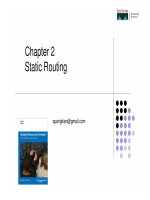Routing Protocols and Concepts: Chapter 4 pptx
Bạn đang xem bản rút gọn của tài liệu. Xem và tải ngay bản đầy đủ của tài liệu tại đây (1.89 MB, 71 trang )
Chapter 4
Distance Vector Routing
Protocols
Routing Protocols and Concepts
2
Topics
Introduction to Distance Vector
Routing Protocols
Distance Vector Technology
Routing Protocol Algorithms
Routing Protocol
Characteristics
Network Discovery
Cold Start
Initial Exchange of Routing
Information
Exchange of Routing
Information
Routing Table Maintenance
Periodic Updates
Bounded Updates
Triggered Updates
Random Jitter
Routing Loops
Defining a Routing Loop
Implications of Routing Loops
Count-to-Infinity Condition
Preventing Routing Loops by
setting a Maximum Metric
Value
Preventing Routing Loops with
Hold-down Timers
Preventing Routing Loops with
the Split Horizon Rule
Preventing Routing Loops with
IP and TTL
Distance Vector Routing Protocols
Today
RIP
EIGRP
Introduction to Distance Vector
Routing Protocols
Distance Vector Technology
Routing Protocol Algorithms
Routing Protocol Characteristics
4
Introduction to Distance Vector Routing Protocols
There are advantages and disadvantages to using any type of routing
protocol.
Some of their inherent pitfalls, and
Remedies to these pitfalls
Understanding the operation of distance vector routing is critical to enabling,
verifying, and troubleshooting these protocols.
5
Introduction to Distance
Vector Routing Protocols
Configuring and maintaining static routes for a large network would be
overwhelming.
What happens when that link goes down at 3:00 a.m.?
6
Introduction to
Distance Vector
Routing
Protocols
RIP: Routing Information Protocol originally specified in RFC 1058.
Metric: Hop count
Hop count greater than 15 means network is unreachable.
Routing updates: Broadcast/multicast every 30 seconds
IGRP: Interior Gateway Routing Protocol - Cisco proprietary
Composite metric: Bandwidth, delay, reliability and load
Routing updates: Broadcast every 90 seconds
IGRP is the predecessor of EIGRP and is now obsolete
EIGRP: Enhanced IGRP – Cisco proprietary
It can perform unequal-cost load balancing.
It uses Diffusing Update Algorithm (DUAL) to calculate the shortest path.
No periodic updates, only when a change in topology.
IGRP and EIGRP: Cisco never submitted RFCs to IETF for these protocols.
7
Meaning of Distance Vector
Distance vector (repeat)
Routes are advertised as vectors of
distance and direction.
Distance is defined in terms of a metric
Such as hop count,
Direction is simply the:
nexthop router or
exit interface.
Routing protocol
Does not know the topology of an
internetwork.
Only knows the routing information
received from its neighbors.
Distance Vector routing protocol does not
have the knowledge of the entire path to a
destination network.
8
Meaning of Distance Vector
R1 knows that:
Distance: to 172.16.3.0/24 is 1 hop
Direction: out interface S0/0/0 toward R2
Remember: R1 does not have a topology map, it only knows distance and
direction!
9
Operation of Distance Vector Routing Protocols
Periodic updates
Some distance vector routing protocols periodically broadcast the entire
routing table to each of its neighbors. (RIP and IGRP)
30 seconds for RIP
90 seconds for IGRP
Inefficient: updates consume bandwidth and router CPU resources
Periodic updates always sent, even no changes for weeks, months,…
10
Operation of Distance Vector Routing Protocols
Neighbors are:
routers that share a link
use the same routing protocol.
Router is only aware:
Network addresses of its own interfaces
Network addresses of its neighbors.
It has no broader knowledge of the network topology.
R1 is
unaware of
R3 and its
networks
Neighbor of R1
Neighbor of R1
11
Operation of Distance Vector Routing Protocols
Broadcast updates (Destination IP 255.255.255.255)
Some protocols use multicasts (later)
Updates are entire routing tables with some exceptions (later)
Neighboring routers that are configured with the same routing protocol will
process the updates.
Other devices such as host computers will also process the update up to
Layer 3 before discarding it.
R1 is
unaware of
R3 and its
networks
Neighbor of R1
Neighbor of R1
12
Routing Protocol Algorithms
The algorithm used by a particular routing protocol is responsible for
building and maintaining the router’s routing table.
The algorithm used for the routing protocols defines the following
processes:
Mechanism for sending and receiving routing information
Mechanism for calculating the best paths and installing routes in the
routing table
Mechanism for detecting and reacting to topology changes
13
Routing Protocol Algorithms
R1 and R2 are configured with RIP.
The algorithm sends and receives updates.
Both R1 and R2 then glean new information from the update.
Sending and receiving updates
14
Routing Protocol Algorithms
Each router learns about a new network.
The algorithm on each router:
makes its calculations independently
updates its routing table with the new information.
Calculating best paths and
installing new routes
15
Routing Protocol Algorithms
Topology change.
LAN on R2 goes down
Algorithm constructs a “triggered” update and sends it to R1.
R1 removes network from the routing table.
Triggered updates - later
Detecting and reacting to
topology change
16
Routing Protocol
Characteristics
Time to convergence:
Faster the better.
Scalability:
How large a network the routing protocol can handle.
Classless (use of VLSM) or classful:
Support VLSM and CIDR
Resource usage:
Routing protocol usage of RAM, CPU utilization, and link bandwidth
utilization.
Implementation and maintenance:
Level of knowledge that is required for a network administrator.
Other ways to compare routing
protocols:
17
Advantages and Disadvantages of Distance Vector
Routing Protocols
18
Comparing Routing Protocol Features
Note: Some of this is relative such as Resource usage and
Implementation and Maintenance.
Network Discovery
Cold Start
Initial Exchange of Routing Information
Exchange of Routing Information
20
Cold Start
Network discovery is part of the process of the routing protocol algorithm
that enables routers to first learn about remote networks.
Router powers up:
Knows nothing about the network topology
Does not know that there are devices on the other end of its links.
Knows only information saved in NVRAM (startup-config).
21
Cold Start
Only knows about it’s own networks
R1:
10.1.0.0 available through interface FastEthernet 0/0
10.2.0.0 available through interface Serial 0/0/0
R2:
10.2.0.0 available through interface Serial 0/0/0
10.3.0.0 available through interface Serial 0/0/1
R3:
10.3.0.0 available through interface Serial 0/0/0
10.4.0.0 available through interface FastEthernet 0/0
22
Initial Exchange of Routing Information
R1:
Sends an update about network 10.1.0.0 out the Serial 0/0/0 interface
with a metric of 1
Sends an update about network 10.2.0.0 out the FastEthernet 0/0
interface with a metric of 1
Receives an update from R2 about network 10.3.0.0 on Serial 0/0/0
with a metric of 1
Stores network 10.3.0.0 in the routing table with a metric of 1
sends receives
23
Initial Exchange of Routing Information
R2:
Sends an update about network 10.3.0.0 out the Serial 0/0/0 interface
with a metric of 1
Sends an update about network 10.2.0.0 out the Serial 0/0/1 interface
with a metric of 1
Receives an update from R1 about network 10.1.0.0 on Serial 0/0/0
with a metric of 1
Stores network 10.1.0.0 in the routing table with a metric of 1
Receives an update from R3 about network 10.4.0.0 on Serial 0/0/1
with a metric of 1
Stores network 10.4.0.0 in the routing table with a metric of 1
sends receivesreceives
24
Initial Exchange of Routing Information
R3:
Sends an update about network 10.4.0.0 out the Serial 0/0/1
interface with a metric of 1
Sends an update about network 10.3.0.0 out the FastEthernet
0/0 interface with a metric of 1
Receives an update from R2 about network 10.2.0.0 on Serial
0/0/1 with a metric of 1
Stores network 10.2.0.0 in the routing table with a metric of 1
sendsreceives
25
Initial Exchange of Routing Information
First round of update exchanges, each router knows about the connected
networks of its directly connected neighbors.
R1 does not yet know about 10.4.0.0
R3 does not yet know about 10.1.0.0.
Full knowledge and a converged network will not take place until there is
another exchange of routing information.









